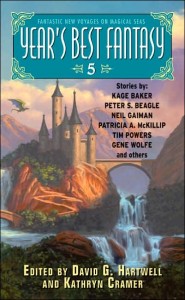 Coming right on the heels of the SF volume is this lovely collection of, as the title suggests, Hartwell and Cramer’s picks for best fantasy stories of the previous year. Everything I said about the SF collection applies here: it’s an excellent selection of stories from a wide range of sources, and it serves as an excellent buffet-style sampling of what the field had to offer in 2004.
Coming right on the heels of the SF volume is this lovely collection of, as the title suggests, Hartwell and Cramer’s picks for best fantasy stories of the previous year. Everything I said about the SF collection applies here: it’s an excellent selection of stories from a wide range of sources, and it serves as an excellent buffet-style sampling of what the field had to offer in 2004.
Robert Reed’s “The Dragons of Summer Gulch” is a clever blend of archaeology, mythology, evolution, and high-stakes frontier exploration, as an entire industry built around the finding of fossilized dragon bones comes to a head when one lucky prospector makes a monumental discovery, one people are willing to kill over.
Theodora Goss’ “Miss Emily Gray” is a Mary Poppinsesque story with a twist and some subtle attitude, while John Kessel’s “The Baum Plan for Financial Independence” is a story about two small-time crooks who discover their own metaphorical rainbow, one which really does change their lives forever. Dale Bailey explores the ways the world might end in “The End of the World as We Know it.” Wry and self-referential, it examines the many ways civilization might take a nosedive, with a most unassuming protagonist.
Kage Baker’s “Leaving His Cares Behind Him” is a typical story about a most atypical young man about town. On the surface, he’s a wastrel, spending money he doesn’t have and getting into all sorts of trouble. However, this younger son of a nobleman has a bizarre secret, and a very dangerous family. A truly enjoyable story with a surprisingly likeable main character, I hope we’ll see more of this world in the future.
“The Problem With Susan,” by Neil Gaiman is a subtle piece that picks up on a lingering concern regarding the Narnia books, when a young reporter goes to interview an elderly professor and makes a strange discovery. Kim Westwood’s “Stella’s Transformation” is a beautifully-told story that looks at an unhappy woman who starts to experience some unusual, positive changes in her life. It’s part-dream, part-romance, and wholly intriguing.
In “Quarry,“ Peter S. Beagle returns to the world and the characters last seen in The Innkeeper’s Song, when he explores how two characters – one an aging shape shifter/trickster, the other a youthful runaway – met and began to bond. John Meaney’s “Diva’s Bones” looks at a unique sort of afterlife/underworld, where the dead provide fuel to power the cities of the living. However, some bones have a power all unto themselves, and some people will do anything for that power. It’s not quite a detective story, not quite a mystery.
“Life in Stone,” by Tim Pratt, follows an aging assassin as he undertakes the greatest task in a long career: killing an unkillable man. Richard Parks weaves a new sort of ghost story/mystery in “A Hint of Jasmine,” in which one man uses technology to bridge the gap between the living and the dead in order to help both sides find resolution.
Joel Lane’s “Beyond the River” is a cautionary tale about what happens to our fantasy worlds when corporate interests change them for the worse. Terry Bisson’s “Death’s Door” is a weird, disturbing tale that looks at a world where, for a time, people are unable to die, no matter how much they might need to.
These, and a number of other fine stories by authors such as Tanith Lee, Gene Wolfe, and Nalo Hopkinson, make this collection worth checking out if you want to see what you might have missed last year.
